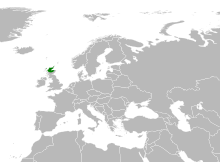Primula scotica, commonly known as Scottish primrose, is a species of flowering plant in the family, Primulaceae, the primroses and their relatives. It was first described by James Smith, and is endemic to the north coast of Scotland.
| Primula scotica | |
|---|---|

| |
| Scientific classification | |
| Kingdom: | Plantae |
| Clade: | Tracheophytes |
| Clade: | Angiosperms |
| Clade: | Eudicots |
| Clade: | Asterids |
| Order: | Ericales |
| Family: | Primulaceae |
| Genus: | Primula |
| Species: | P. scotica
|
| Binomial name | |
| Primula scotica | |

| |
| The range of Primula scotica.[1] | |
| Synonyms | |
|
Aleuritia scotica (Hook.) J. Sojak synonyms_ref = [2] | |
Description
editPrimula scotica is a low perennial or sometimes biennial plant[3]: 548 only a few centimetres tall, even when in full bloom, with mealy stems and leaves. The leaves are broadest at the middle and are not toothed and form a low rosette. It has small, purple flowers around 8 millimetres (0.31 in) in diameter with five heart-shaped purple petals and a bright yellow eye in the centre.[4]The sepals are rounded and rather blunt.[5]
Distribution
editPrimula scotica is endemic to northern Scotland where it is found along the northern, Pentland Firth, coast of the mainland in the Highland (council area) in the former counties of Caithness and Sutherland and on the other side of the Pentland Firth in the Orkney Islands.[6] A survey in 2008 found the Scottish primrose to be present at 194 sites from Durness in Sutherland to Dunbeath in north eastern Caithness.[4]
Habitat and biology
editPrimula scotica grows in coastal heaths and grassland.[7] The majority of the sites where this species occurs are within a few hundred metres of the sea and there is normally a mosaic of heath, grassland and rocky outcrops.[4]
P. scotica can only reproduce from seed. It comes into flower twice each year, the first flowering takes place in the early spring and the second in the summer, however, some plants do not flower. Reproduction is normally through self-fertilisation but when the plants are cross-pollinated by insects this can lead to longer-lived more vigorous plants. This species requires short vegetation to survive and can often be a coloniser of small areas of bare soil, for example in the slots made by the hoofs of ungulates. Scottish primroses are perennial and once they are mature they can persist at a site long after it has become unsuitable for germination. Severe winters can lead to high mortality of young plants.[4]
Taxonomy
editPrimula scotica is most closely related to Primula scandinavica which occurs in Norway and north-west Sweden, and more distantly to the Arctic species Primula stricta.[8]
Threats and conservation
editPrimula scotica requires short vegetation and its habitat can become unsuitable if grazing is too light, similarly too heavy grazing can also have a deleterious effect on the quality of habitat, especially if the plants are consumed by the herbivores. There has also been a loss of habitat to agricultural intensification and to tree planting. Climate change is also a threat to this species which is sensitive to extremes of climate.[4] Conservation of a few sites with appropriate management, such as grazing, should secure this rare plant which has low genetic diversity.[4]
Culture
editPrimula scotica is the county flower of Caithness[7] and was the original symbol of the Scottish Wildlife Trust.[4]
References
edit- ^ Guggisberg, A.; Mansion, G.; Conti, E. (2009). "Disentangling Reticulate Evolution in an Arctic-Alpine Polyploid Complex". Systematic Biology. 58 (1): 55–73. doi:10.1093/sysbio/syp010. hdl:20.500.11850/106156. PMID 20525568.
- ^ "Species Details : Primula scotica Hooker". Catalogue of Life. Retrieved 2 March 2020.
- ^ Stace, C. A. (2019). New Flora of the British Isles (Fourth ed.). Middlewood Green, Suffolk, U.K.: C & M Floristics. ISBN 978-1-5272-2630-2.
- ^ a b c d e f g "Scottish Primrose Primula scotica" (PDF). Scottish Wildlife Trust Priority Species Profile. Scottish Wildlife Trust. Retrieved 2 March 2020.
- ^ Richard Fitter; Alastair Fitter; Marjorie Blamey (1996). Collins Pocket Guide to the Wild Flowers of Britain and Northern Europe (5th ed.). Harper Collins Publishers. pp. 184–185. ISBN 0 00 220062 7.
- ^ "Scottish Primrose Primula scotica". Scottish Wildlife Trust. Retrieved 2 March 2020.
- ^ a b "Scottish primrose Primula scotica". Plantlife. Retrieved 2 March 2020.
- ^ Bullard, E.R.; Shearer, H.D.H.; Day, J.D.; Crawford, R.M.M. (1987). "Survival and Flowering of Primula scotica Hook". Journal of Ecology. 75 (3): 589–602. doi:10.2307/2260191. JSTOR 2260191.
External links
edit- Media related to Primula scotica at Wikimedia Commons
- Data related to Primula scotica at Wikispecies